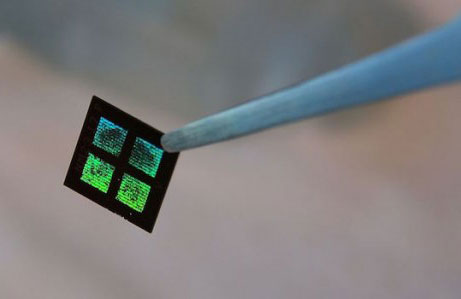| Feb 15, 2016 |
Using a microchip to build a first-ever artificial kidney
|
|
(Nanowerk News) Vanderbilt University Medical Center nephrologist and associate professor of medicine Dr. William H. Fissell IV, is making major progress on a first-of-its kind device to free kidney patients from dialysis. He is building an implantable artificial kidney with microchip filters and living kidney cells that will be powered by a patient’s own heart.
|
|
“We are creating a bio-hybrid device that can mimic a kidney to remove enough waste products, salt and water to keep a patient off dialysis,” said Fissell.
Fissell says the goal is to make it small enough, roughly the size of a soda can, to be implanted inside a patient’s body.
|
 |
| An example of the microchip filter being used inside Fissell's artificial kidney. (Image: Vanderbilt University)
|
|
Nanotechnology
|
|
The key to the device is a microchip.
|
|
“It’s called silicon nanotechnology. It uses the same processes that were developed by the microelectronics industry for computers,” said Fissell.
|
|
The chips are affordable, precise and make ideal filters. Fissell and his team are designing each pore in the filter one by one based on what they want that pore to do. Each device will hold roughly fifteen microchips layered on top of each other.
|
|
But the microchips have another essential role beyond filtering.
|
|
“They’re also the scaffold in which living kidney cells will rest,” said Fissell.
|
|
Living Kidney Cells
|
|
Fissell and his team use live kidney cells that will grow on and around the microchip filters. The goal is for these cells to mimic the natural actions of the kidney.
|
|
“We can leverage Mother Nature’s 60 million years of research and development and use kidney cells that fortunately for us grow well in the lab dish, and grow them into a bioreactor of living cells that will be the only “Santa Claus” membrane in the world: the only membrane that will know which chemicals have been naughty and which have been nice. Then they can reabsorb the nutrients your body needs and discard the wastes your body desperately wants to get rid of,” said Fissell.
|
|
Avoiding Organ Rejection
|
|
Because this bio-hybrid device sits out of reach from the body’s immune response, it is protected from rejection.
|
|
“The issue is not one of immune compliance, of matching, like it is with an organ transplant,” said Fissell.
|
|
How the Device Works
|
|
The device operates naturally with a patient’s blood flow.
|
|
“Our challenge is to take blood in a blood vessel and push it through the device. We must transform that unsteady pulsating blood flow in the arteries and move it through an artificial device without clotting or damage.”
|
|
Fluid Dynamics
|
|
And that’s where Vanderbilt biomedical engineer Amanda Buck comes in. Buck is using fluid dynamics to see if there are certain regions in the device that might cause clotting.
|
|
“It’s fun to go in and work in a field that I love, fluid mechanics, and get to see it help somebody,” said Buck.
|
|
She uses computer models to refine the shape of the channels for the smoothest blood flow. Then they rapidly prototype the new design using 3-D printing and test it to make the blood flow as smoothly as possible.
|
|
Future Human Trials
|
|
Fissell says he has a long list of dialysis patients eager to join a future human trial. Pilot studies of the silicon filters could start in patients by the end of 2017.
|
|
“My patients are absolutely my heroes,” said Fissell. “They come back again and again and they accept a crushing burden of illness because they want to live. And they’re willing to put all of that at risk for the sake of another patient.”
|

